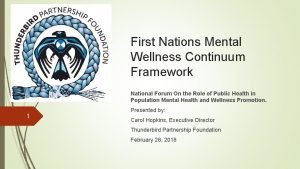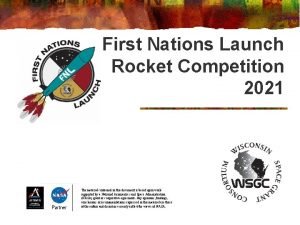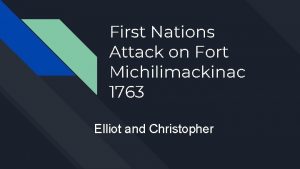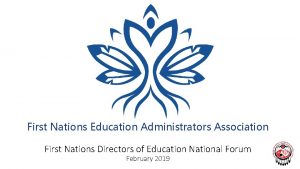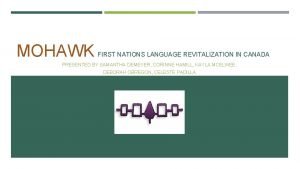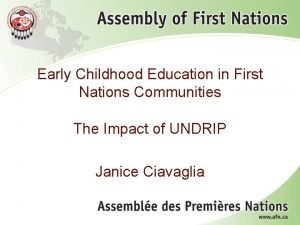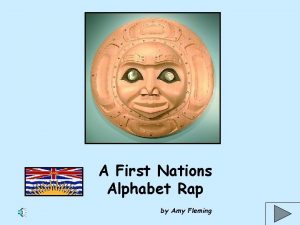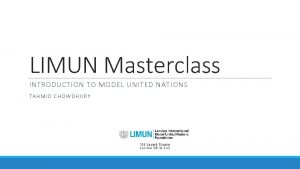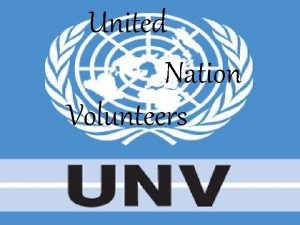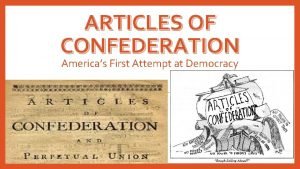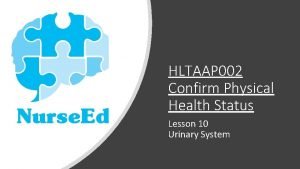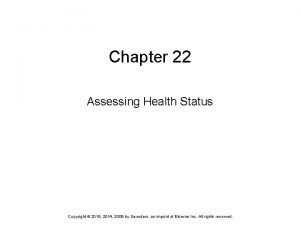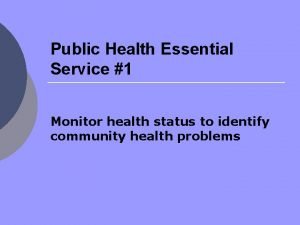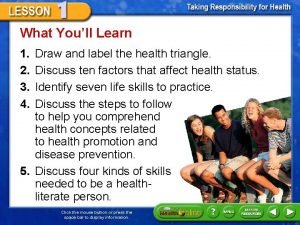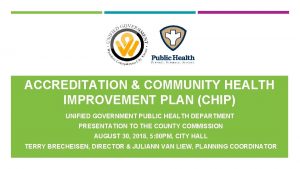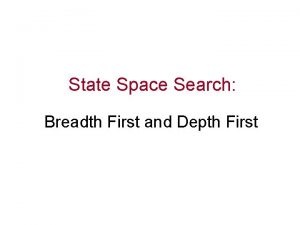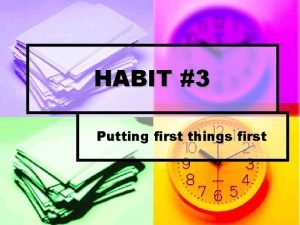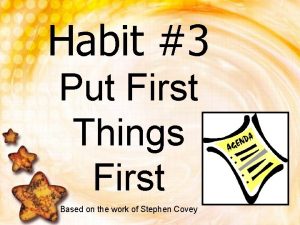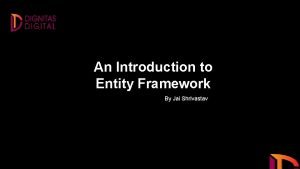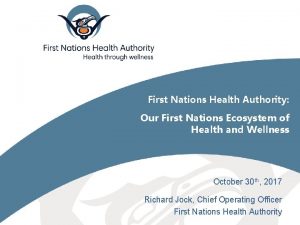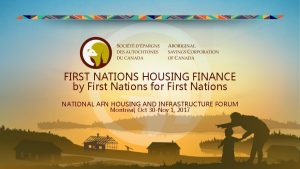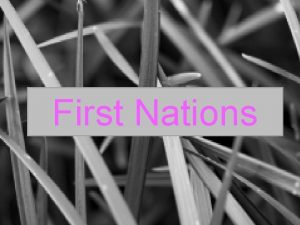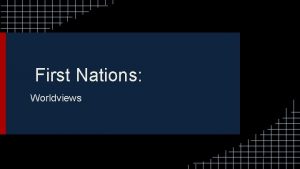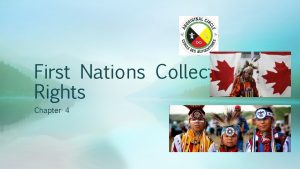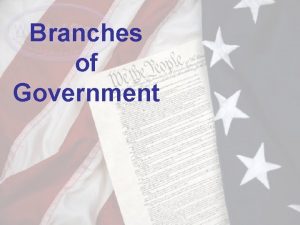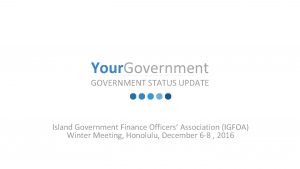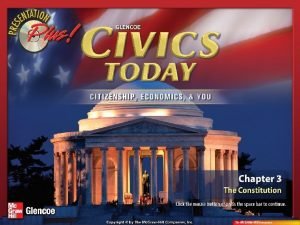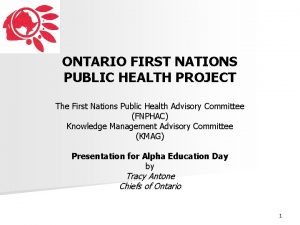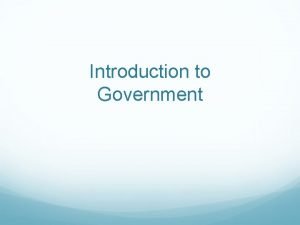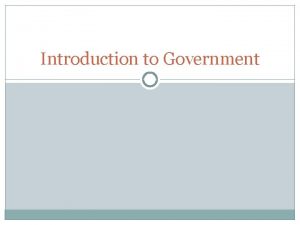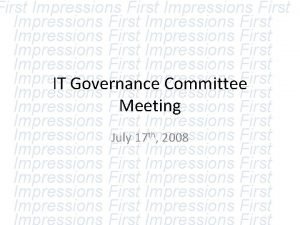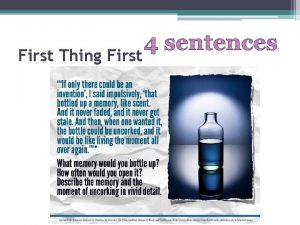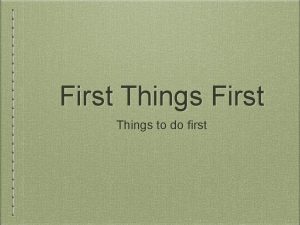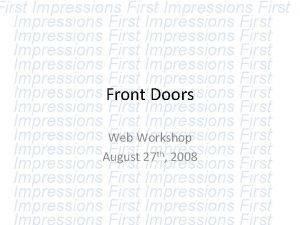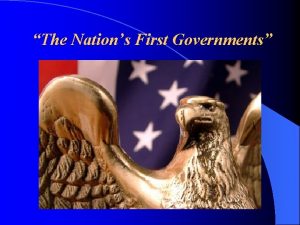First Nations Health INTRODUCTION Health Status Government Health






























- Slides: 30

First Nations Health • • • INTRODUCTION Health Status Government Health Policy Users & Providers Contemporary Healing Conclusion

Lose Yourself Imperialism, Control – the time has come. Forget your culture and faith, forget who you are. There will be diversity, but not by your choice. You will lose your identity, you will lose your voice. Do not be afraid, there is nothing to fear. All will be better, now we are here. You are all savages, living off the land. Us men have the power, all within our hands, There is no use in giving to the Earth. We control that too, so we will destroy it, and then do the same with you.

Lose Yourself Our empire will prevail, and no one will know you existed. This colonization will take place, and we will make it seem like you insisted. Your way of life is false, irrational, and superstitious. You call our way of aiding you, something tricky and malicious. Your songs and dance are a way of magic and curses, But we can see through you and write our own verses. Let this colonization begin, you have nothing to fear. All will be better, now that we are here. by Anjanie Ramnarine

First Nations Health • • • Introduction HEALTH STATUS Government Health Policy Users & Providers Contemporary Healing Conclusion

Aboriginal Health Today: • First Nations Canadians die 20 years earlier than non-Aboriginal Canadians • Most common causes of death among Aboriginals car accidents, drowning & fire • Aboriginal infant mortality rates 14. 3 per 1000 vs 6. 7 per 1000 in general population • Suicide & self-inflicted injuries in Aboriginal communities 3 times those in the general Canadian population

Aboriginal Health Today: • Tuberculosis rates 81. 3 cases per 100 000 Aboriginal persons vs 7. 4 cases per 100 000 general population • Diabetes 2 to 5 times higher for Aboriginal than non-Aboriginal populations. • HIV/AIDS – 5 times national level in Aboriginal population • For story re TB in Northern Saskatchewan Aboriginal community check out: http: //archives. cbc. ca/health/disease/clips/5326/

“Peggy has another baby in her care. Old Annie called her about a child crying in the bush behind her house. So Peggy went to see what was wrong and found an eight-month baby who had been abandoned. The infant was covered with mosquito bites. The parents left the child in the care of older sibling and went drinking in town. But the girls who were supposed to look after it felt like sniffing gasoline. So they took the baby and threw it in the bush. ” Anastasia Shkilnyk’s Diary Grassy Narrows, 1976

When I guided in the 1950 s, there were 500 people at Grassy – trappers, commercial fishers, fishing & hunting guides, & band functionaries. About 20% of the families had no paychecks, but they could live off rice & fish & wild meat & trade goods for their furs. No one was on welfare. Bob Rodgers, former hunting guide

On the old reserve we lived in family groups… We got together at feasts & celebrations… If you got mad at somebody you had to paddle a mile or two to give him a piece of your mind. In the new place, crowded together… we weren’t used to it. The fights & broken windows & battered doors, the house fires, the drugs, the bootleg booze – everything changed. Ivy Keewatin, Grassy Narrows Resident

Bob Rodgers with Ivy Keewatin, “Return to Grassy Narrows: A poisoned community tells its 40 -year-old story, ” Literary Review of Canada, vol 17, no 1, January/February 2009, pp. 22 -23

Aboriginal Health & the Environment • NFB clip from Northern Ontario featuring Homer Seguin, regional representative of the United Steelworkers, Winona La. Duke, Native rights activist, and Gilbert Oskaboose. http: //www 3. nfb. ca/enclasse/doclens/visau/index. php? mode=theme&la nguage=english&theme=30662&film=18301&excerpt=612114

First Nations Health • • • Introduction Health Status GOVERNMENT HEALTH POLICY Users & Providers Contemporary Healing Conclusion

Government Health Policy • Until 1945 - separate health provision for Aboriginal peoples • 1945 – responsibility moved to federal Dept of Health & Welfare • 1969 - ‘White Paper’

Government Health Policy • 1979 – new federal Indian Health Policy • 1986 Federal Indian Health Transfer Policy

First Nations Health • • • Introduction Health Status Government Health Policy USERS & PROVIDERS Contemporary Healing Conclusion

Moira Coady R. N.

“Many Indians have little understanding of the meaning of good health because of cultural differences and education deficiencies. Indians exhibit little awareness of what is meant by good health and because of this lack of awareness there is a tendency to both over and under-utilize health services… Indians frequently fail to recognize significant symptoms and delay seeking treatment until they are acutely ill. ” Booz-Allen Report, 1969

First Nations Health • • • Introduction Health Status Government Health Policy Users & Providers CONTEMPORARY HEALING Conclusion

Community health services

Health Transfer Policy: William Charles Band, Saskatchewan

Aboriginal Health & Land Claims: • health provision on bargaining table alongside issues of land ownership, selfgovernment & selfdetermination • example, late 1980 s Sechlet Band, B. C.

Aboriginal Health Professionals: • 1991 - only 18 -25 practicing First Nations Physicians in Canada • 1979 - University of Manitoba est first Special Premed Studies program for First Nations students • 1985 - University of Saskatchewan National Native Access Program to Nursing

Re-emergence of Traditional Medicine:

Re-emergence of Traditional Medicine:

First Nations Health • • • Introduction Health Status Government Health Policy Users & Providers Contemporary Healing CONCLUSION

• The Weight of the World NFB documentary about a community diabetes program in the First Nations community of Sandy Lake, in Manitoba. http: //www. nfb. ca/film/weight-of-the-world-extras-aboriginalsetting/

Pictou Landing Health Center, Nova Scotia 2008 The Pictou Landing Health Centre building wraps around the central space of a Mi'kmaq First Nation fishing community & houses clinics, consultation rooms & a community meeting space. Building materials draw on historic indigenous traditions & the building uses geothermal energy.

http: //www. youtube. com/watch? v=8 RSn 9 d 9 p. MN 8 Urban Aboriginal Community Kitchen Garden Project, Vancouver

http: //www. youtube. com/watch? v=8 RSn 9 d 9 p. MN 8

 First nations mental wellness continuum framework
First nations mental wellness continuum framework Medicine wheel north
Medicine wheel north First nations launch
First nations launch First nations attack fort michilimackinac
First nations attack fort michilimackinac Aboriginal simple machines
Aboriginal simple machines Fneaa
Fneaa Language
Language Janice ciavaglia
Janice ciavaglia First nations alphabet
First nations alphabet Introduction to model united nations
Introduction to model united nations Un introduction
Un introduction National government vs federal government
National government vs federal government America's first attempt at government was
America's first attempt at government was Merits of parliamentary government
Merits of parliamentary government Local government finance
Local government finance Confirm physical health status
Confirm physical health status Community health status indicators
Community health status indicators Assessing health status chapter 22
Assessing health status chapter 22 Monitor health status
Monitor health status Lesson 6 employee health status
Lesson 6 employee health status How can random events affect health status
How can random events affect health status Pc health status
Pc health status Unified government public health department
Unified government public health department 7 habits maturity continuum
7 habits maturity continuum Breadth first vs depth first
Breadth first vs depth first Sdl first vs code first
Sdl first vs code first Habit 3 lesson plans
Habit 3 lesson plans Put first things first
Put first things first Entity framework 7 release date
Entity framework 7 release date First to file vs first to invent
First to file vs first to invent Data structure stack
Data structure stack
